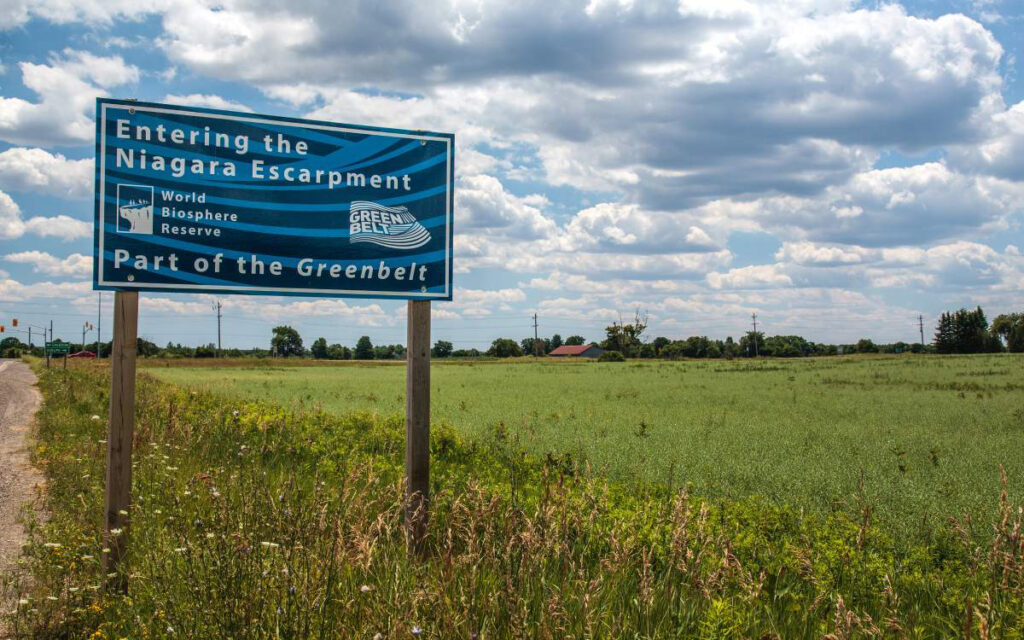
A recently released study by planning consultant firm Malone Given Parsons Ltd. (MGP) posits that new land must be opened up for housing within the Greater Golden Horseshoe and Greater Toronto Area in order to account for expected population growth. Photo Credit: Greenbelt Foundation.
A recently released study by planning consultant firm Malone Given Parsons Ltd. (MGP) posits that new land must be opened up for housing within the Greater Golden Horseshoe and Greater Toronto Area in order to account for expected population growth.
The study was commissioned for the Building Industry and Land Development Association (BILD) and the Ontario Home Builders’ Association (OBHA) and supported by the West End Home Builders’ Association (WE HBA).
The report provides four key recommendations. First, that sufficient land be made available for a market-based supply of housing to meet forecasted growth needs. Second, that missing middle housing intensification be unlocked. Third, that funding should be provided for infrastructure to develop housing in existing Designated Greenfield Areas (DGAs). And fourth, that a “modern and stable” planning system be implemented.
The study notes that with the Government of Ontario’s decision to reverse its plan to open more land for housing the housing shortfall could increase to 206,800 grade-related (10,400 ha) plus any shortfall in apartment growth.
It also notes that if land is not added for residential growth then cities would have to entirely redevelop many existing neighbourhoods.
The report also says that the provincially approved Official Plans “do not perpetuate ‘sprawl.’”
“‘Sprawl’ occurs when the rate of growth in the land base is greater than the rate of population growth. The Greater Toronto and Hamilton Area (GTHA) will accommodate 24 per cent population growth compared to a seven per cent increase in housing land area,” the document continues.
The study also provides an in-depth analysis of each city within the Greater Golden Horseshoe.
For the City of Hamilton, the analysis details that housing suitability is worsening within the municipality.
A reported 11 per cent of one-bedroom dwellings (up from eight per cent in 2016) and nine per cent of two-bedroom dwellings (up from seven per cent in 2016) accommodating households that require additional bedrooms “in order to be housed suitably.”
It reiterates that the City of Hamilton is expected to be home to 820,000 people and house 360,000 jobs by 2051.
The document also says that Hamilton is forecasted to see 75 per cent (82,700 units) apartment growth from 2021 to 2051 which is significantly higher than the province’s forecasted apartment growth of 19 per cent (20,600 units).
Researchers further conclude that Hamilton will have a projected shortfall of 62,100 grade-related housing units by 2051, equating to a land shortfall of approximately 3,100 ha.
“If this shortfall were provided for in the Built-up Urban Area of Hamilton it would require 31 per cent of existing neighbourhoods to be redeveloped.”
Mike Collins-Williams, CEO of the WE HBA which supported the study, issued comments in a press release.
“The need for additional land supply has been clearly identified by planning experts as necessary to accommodate population growth and limit the continued displacement of residents,” said Collins-Williams. “Local political opposition and disruptions in our planning system make it increasingly difficult to bring new ground-oriented housing online.”
It remains to be seen if an adequate amount of land will be opened up for housing as 2051 approaches.

Based in Hamilton, he reaches hundreds of thousands of people monthly on Facebook, Instagram, TikTok, and Twitter. He has been published in The Hamilton Spectator, Stoney Creek News, and Bay Observer. He has also been a segment host with Cable 14 Hamilton. In 2017, he received the Chancellor Full Tuition Scholarship from the University of Ottawa (BA, 2022). He has also received the Governor General’s Academic Medal. He formerly worked in a non-partisan role on Parliament Hill in Ottawa.






